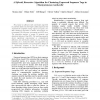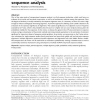1278 search results - page 29 / 256 » Information Analysis of DNA Sequences |
ICPR
2006
IEEE
15 years 11 months ago
2006
IEEE
We present an efficient, fully automated algorithm to assemble ESTs into full-length cDNA sequences that represent the complete coding regions of a gene. Our EST clustering algori...
101
Voted
BMCBI
2008
14 years 10 months ago
2008
Background: Normalization is essential in dual-labelled microarray data analysis to remove nonbiological variations and systematic biases. Many normalization methods have been use...
71
Voted
BMCBI
2006
14 years 10 months ago
2006
Background: Publicly accessible EST libraries contain valuable information that can be utilized for studies of tissue-specific gene expression and processing of individual genes. ...
WABI
2005
Springer
15 years 3 months ago
2005
Springer
Abstract. Traditional sequence comparison by alignment applies a mutation model comprising two events, substitutions and indels (insertions or deletions) of single positions (SI). ...
78
Voted
BIB
2006
14 years 10 months ago
2006
One of the major goals of computational sequence analysis is to find sequence similarities, which could serve as evidence of structural and functional conservation, as well as of ...


